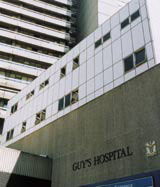Design treatment for NHS
How will design be used to improve the experience for both patient and visitor?

The Royal Brompton & Harefield Hospital is breaking new ground with its latest design project, commissioning digital design consultancy All of Us to look at ways of boosting patient interaction (see page 6).
With a brief to reduce anxiety and review the patient process within the cardiac suite, All of Us has proposed experimental digital design solutions, recommending the installation of a ‘sound corridor’ to relax patients as they enter the hospital, as well as an audio- visual ‘window’.
‘This approach is characterised by looking at the problem from the perspective of the user and not the organisation, which is very much a design-based philosophy. It should be an important role in the design of hospitals and their systems,’ says Mickey Stretton, design director at All of Us.
Now it seems other hospitals are joining the fray: while architecture has long been championed as a way to improve the patient/ visitor experience, how best to apply ‘appropriate’ design across interiors, materials, lighting and signage, for example, has been a contentious, and until now, largely ignored issue.
According to Health Secretary John Reid, the NHS is in the middle of its biggest hospital building programme to date, so little wonder that design is rising up the agenda. Ultimately, more than 100 hospital schemes will benefit from a £4bn investment and the design sector is responding with speed, devising complex prescriptions for socio-economic issues.
Guy’s & St Thomas’ NHS Foundation Trust, one of the largest hospital trusts in the UK, is currently ploughing £3.7m into a three-year design initiative called Friendly Accessible Clean Environment Project (DW 4 November).
It is building an in-house design group to be headed by Lorna Wain, who used to work as design and arts advisor for Kings College Hospital. She joins in December and will oversee design across the foundation’s network, with a brief to refurbish entrances, receptions and waiting rooms.
Wain says design must go beyond a cosmetic makeover and argues there is currently a gap in the sector because the NHS has traditionally focused on art and architecture, not real design.
She says, ‘You have these beautiful buildings, but they are filled with absolute rubbish. The furniture is poorly made, there is abysmal design and the result is items [that are] falling apart rapidly. There is no-one championing good design within the NHS. The case for architecture and art has been won, but not for design.
‘Who is making the design decisions?’ Wain asks. ‘This is largely a forgotten area.’ Wain wants the Face project to ‘set the design agenda’ and hopes it will create a trend for hospitals to build in-house teams and apply integrated design strategies in a responsible and appropriate way.
She adds, ‘There are very few good designers in the NHS, which tends to buy consultants on a project-only basis, meaning there is little design coherence.’
Colum Lowe, former head of design at Homebase, leads the National Patient Safety Agency, a special health authority created by the NHS to analyse how design can help reduce the 900 000 incidents where patients are harmed in hospitals across the UK each year. He was appointed last year as design manager (DW 20 November 2003).
Like Stretton, he thinks the issue of usability is paramount. ‘While it is important to have buildings that make positive statements, they must also be appropriately user-centric,’ he says.
Creating single rooms as opposed to wards, generating adequate ventilation and ensuring there is plenty of natural light and reduced levels of noise are just some of the issues Lowe thinks designers should be addressing. He points to the American hospital, St Joseph’s Community Hospital in Wisconsin, and St Olavs in Norway as providing design templates and praises them for ‘using really successful, experimental design solutions’.
The Commission for Architecture and the Built Environment also has its checklists for what constitutes successful hospital design. These are gleaned from extensive research, such as its Healthy Hospitals paper that enlisted four architects and design groups to create design-led answers for the health service (DW 27 November).
Good landscaping, uncluttered entrances, clear signage and graphics, bright, spacious interiors and an easily navigable layout are all-important design considerations, says Peter Jenkins, campaigns advisor at Cabe.
But he adds, ‘Money can be a big restriction. We must challenge perceptions and convince [the NHS] that spending on design, as a long-term investment, pays off.’
Like most ventures relating to the public sector, getting the pot of gold for funding can prove to be an obstacle, but all the more reason for designers to respond with cost-effective and innovative solutions.
As one of the world’s largest public service organisations, the NHS is in an ideal position to demonstrate globally how design projects should be about so much more than a fresh lick of paint or new building work. Ultimately, it can provide a platform to revolutionise the experience of both patients and visitors, and design activists must rally to the cause.
-
Post a comment




